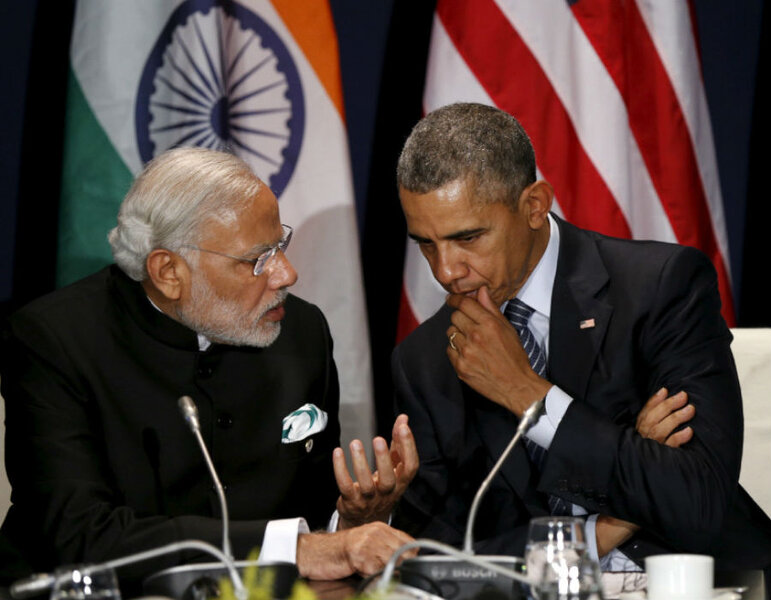HFC ban: Can world leaders find a fair path for both rich and poor nations?
Loading...
Coming off the success of the Paris Agreement, which was ratified last week, world leaders meet in Kigali, Rwanda, this week to take another step forward on climate. Their target: hydrofluorocarbons (HFCs).
HFCs are the world’s fastest-growing greenhouse gases, with a warming effect around 1600 times as powerful, on average, as carbon dioxide. The gases are the latest in a series of replacements to chlorofluorocarbons, or CFCs, the man-made compounds once used in solvents, in aerosols, and as refrigerants, until scientists identified the compounds as culprits in the destruction of the ozone layer.
In 1992, world leaders agreed to mandate the elimination of CFCs in developed countries by 1997. Since the phasing-out of CFCs, the hole in the ozone layer over Antarctica has shown significant signs of improvement, but some of the chemicals that have replaced CFCs have brought new challenges.
Advocates of cutting HFCs say limiting the use of these gases and improving efficiency could cut global warming by 0.5 degrees Celsius by 2050. But some say the drawdown should not be universally applicable, at least at first. Is there a way to make the reductions work for everyone?
HFCs were intended as “transitional substitutes” that would bridge the divide between chlorofluorocarbons and substances with no warming effect. However, increased use of these gases – as global demand for air-conditioning and refrigerators grows – means that by 2050 emissions “could rise so high that they almost cancel the tremendous climate benefits won earlier by the phase-out of CFCs and other ozone-depleting substances,” according to the UN Environmental Program. Action on HFCs could, therefore, be a key part of meeting Paris Agreement commitments.
A majority of world nations are united on the need to address HFC emissions. Small island states have long been at the forefront of this movement, because they are among the states most threatened by rising sea levels associated with climate change. The Federated States of Micronesia and Mauritius first proposed phasing out HFCs in 2009.
President Obama incorporated the issue of HFCs into his foreign policy, helping to forge a broader movement for action. Last year, the EU and China agreed to work together, alongside other countries, to tackle the issue.
Where countries differ is the timetable. A growing consensus of developed countries and small island developing states consider the urgency of the threat an imperative not to delay. They also argue that, because these gases are man-made, the way to curb emissions is simple: reduce production and usage. All in all, 100 countries — including the entire African continent and the European Union — have called for an “early freeze date” on production of HFCs.
A decision on HFCs could make or break countries’ climate commitments, says Peter M. Christian, president of the Federated States of Micronesia.
“An ambitious HFC amendment is the low-hanging fruit in measures to reduce global warming. Harvesting it now will increase the confidence to take other challenging measures, and failure to do so would gravely undermine the momentum built up in Paris,” he wrote in The Diplomat, international current-affairs magazine for the Asia-Pacific region.
Other developing countries, however, are concerned about the effect of a rapid phase-out on their economies and societies, particularly as ever more people need affordable cooling solutions to counteract rising temperatures. India suggested that developing nations should not be asked to reduce their use of HFCs until 2031.
Developing countries have historically argued to be allowed to pursue national development, even if it means generating emissions. They argue that today’s industrialized nations got to where they are thanks to their exploitation of fossil fuels, and developing countries should be afforded the same opportunities for development. While the United States has emitted almost 1,200 tons of carbon dioxide per person since 1850, India currently stands at 31 tons per capita.
Allowing developing countries to transition over a longer period of time may not be the answer, some experts say. The European Council, in a report on alternatives to HFCs and their molecular cousins, hydrochlorofluorocarbons (HCFCs), argued that developing countries should opt instead for “future-proof” solutions, including low-impact alternatives and energy-efficiency measures.
“These countries have the chance to leapfrog high [global warming potential] HFCs and to switch to climate-friendly substances and technologies immediately,” the authors wrote.
Bridging the divide in Kigali this week may hinge on demonstrating that viable alternatives to HFCs already exist. While there is no “one-size-fits-all” solution, there are ways to fill almost all the functions of HFCs, the UN Environmental Program says.
Alternative substances with lower emissions impact include ammonia, carbon dioxide, and hydrocarbons, according to the UN report. There are cost-effective, efficient alternatives in all but 25 percent of cases, the European Commission says – and that number may actually be as low as 10 percent. Solutions are expected by 2025, meaning that they should come in time for any incremental drawdown.
Building design and retrofitting are key components of any strategy that seeks to reduce the demand for cooling. Redesigning equipment may also help to reduce leakage and limit emissions.
Another facet of the solution is providing funds for developing countries as they transition away from HFCs. The Montreal Protocol, which will be amended this week if countries choose to mandate a phase-out, already has a Multilateral Fund with $508 million to support progress on these issues in developing countries between 2015 and 2017.
Other countries that support swift action – including the United States, Britain, Germany, and Japan – have pledged a further $27 million, while $53 million is available in private philanthropic contributions. More may be needed, but this funding suggests that support for developing countries would be forthcoming if they were asked to commit to an early transition away from HFCs.
“An ambitious amendment is the quickest and least expensive way to reduce the effects of climate change,” Durwood Zaelke, president of the Institute for Governance and Sustainable Development, told Scientific American.








